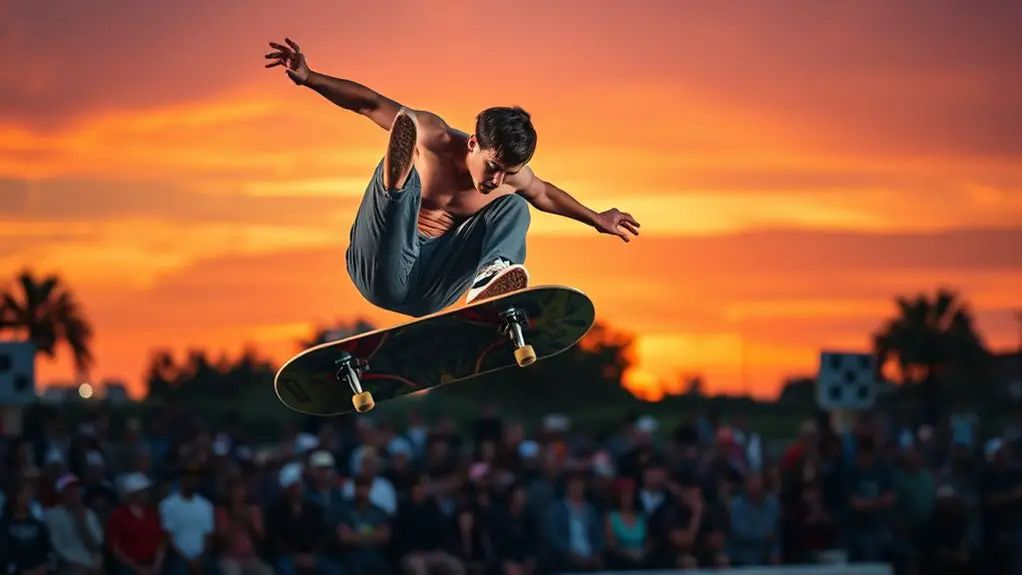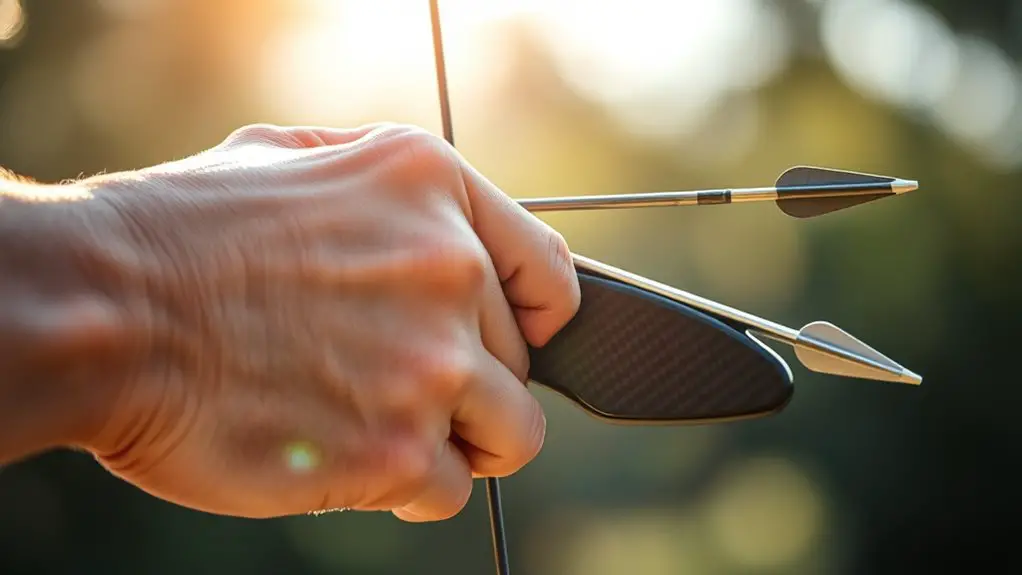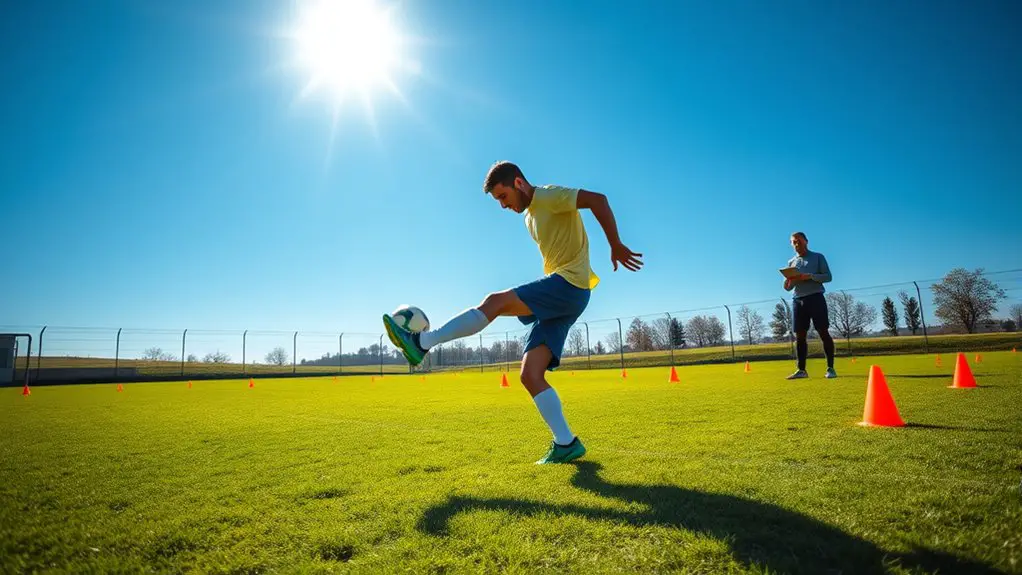The biomechanics of performing aerial tricks in extreme sports involves a precise blend of physics principles. You'll rely on understanding your center of gravity, control over angular momentum, and torque manipulation. Mastering muscle engagement and strength training is essential for maintaining balance and executing tricks successfully. Timing and coordination play a critical role in your performance. Engaging with innovative training techniques can enhance your skills further. There's so much more to explore about these concepts!
Understanding the Basics of Biomechanics in Aerial Sports
When you plunge into aerial sports, understanding the basics of biomechanics can make all the difference in your performance. Mastering aerial dynamics is essential for executing tricks with precision and flair. You'll find that your body's movements directly influence how effectively you can soar through the air.
Grasping the principles of force, momentum, and balance will empower you to perform tricks that feel fluid and effortless. As you gain confidence, you'll learn how to manipulate your body position to achieve ideal lift and control. Incorporating plyometric exercises into your training regimen can enhance your power and agility, allowing for more explosive movements during aerial tricks.
Focusing on the timing of your movements enhances your trick execution, allowing you to shift smoothly from one maneuver to another. Remember, every small adjustment can lead to a more exhilarating experience. Embrace the freedom of the skies, and let biomechanics guide you to new heights. With practice, you'll reveal your potential and truly own each aerial adventure.
The Role of Center of Gravity in Aerial Tricks
When you're performing aerial tricks, your center of gravity plays an essential role in maintaining balance. A slight shift can greatly impact your rotation and overall control in the air. Understanding this concept can help you execute tricks more effectively and safely.
Importance of Balance
Although aerial tricks in extreme sports can seem exhilarating and effortless, the importance of balance cannot be overstated. Mastering balance techniques is essential for achieving that sense of freedom you crave in the air. Your center of gravity plays a significant role in maintaining dynamic equilibrium, allowing you to execute those jaw-dropping moves with precision. When you control your body's position and weight distribution, you're not just floating; you're harnessing the laws of physics to defy gravity. By focusing on balance, you can enhance your performance and minimize the risk of falls. So, embrace the art of balance, and let it guide you through the thrill of each aerial trick, elevating your experience in extreme sports.
Impact on Rotation
As you soar through the air executing aerial tricks, the role of your center of gravity becomes essential for mastering rotation. Understanding rotation mechanics can set you free to perform with finesse. When you adjust your aerial alignment, you're actively shifting your center of gravity, influencing how quickly and smoothly you spin. If your center of gravity is too far from your body, you'll struggle to control your rotation, making it harder to land cleanly. Conversely, by tucking in your limbs, you can tighten your rotation, allowing for a more dynamic performance. Embrace this knowledge, and you'll find that the freedom of aerial tricks lies in the delicate balance of your center of gravity, helping you achieve the exhilarating spins and flips you crave.
Physics of Rotation: Angular Momentum and Torque
Understanding the physics of rotation is essential for mastering aerial tricks in extreme sports, since it involves the interplay of angular momentum and torque. When you launch into the air, your angular velocity plays a significant role in how fast you spin. The faster you spin, the more angular momentum you generate, which is key to achieving those jaw-dropping tricks.
However, your rotational inertia, which depends on how your body is positioned, can affect your spin rate. By pulling your limbs close to your body, you reduce rotational inertia, allowing you to spin faster. Conversely, extending your limbs increases inertia, slowing you down.
To maintain control and execute those thrilling maneuvers, you need to harness torque effectively. By shifting your weight at the right moments, you can manipulate your rotation, maximizing your freedom in the air. Additionally, developing explosive power through targeted training can significantly enhance your aerial performance. Mastering these concepts will elevate your aerial game and enhance your adrenaline-fueled adventures.
Muscle Engagement and Strength Training for Aerial Maneuvers
To master aerial maneuvers, you need to focus on core stability, upper body strength, and flexibility. Each of these elements plays a vital role in your ability to execute tricks with precision and control. By training these areas, you'll enhance your performance and reduce the risk of injury. Developing your core strength can significantly improve movement efficiency, allowing you to perform aerial tricks more fluidly and with greater control.
Core Stability Training
Core stability training plays an essential role in mastering aerial maneuvers in extreme sports. It's all about harnessing your body's power and control to achieve that exhilarating freedom in the air. By focusing on core exercises, you'll develop the strength and endurance needed to maintain balance during flips, spins, and twists. Incorporating stability techniques into your routine not only enhances your performance but also reduces the risk of injury. Whether it's planks, bridges, or rotational movements, building a solid core allows you to shift smoothly through each trick. So, embrace the challenge and feel the thrill as you elevate your skills. With a strong core, you're not just performing; you're flying with confidence and grace.
Upper Body Strength
Upper body strength is essential for executing aerial maneuvers in extreme sports, as it directly influences your ability to control and stabilize your body mid-air. When you're soaring through the sky, strong arms and shoulders allow you to grip, pull, and twist with confidence. Incorporating specific strength training exercises, like pull-ups and push-ups, can enhance your muscle engagement, giving you the power to perform complex tricks. Don't underestimate the importance of your back and chest muscles; they play a significant role in maintaining balance and control. As you build your upper body strength, you'll not only improve your performance but also gain the freedom to express yourself creatively in the air. Embrace the challenge, and let your body soar!
Flexibility and Mobility
Flexibility and mobility are essential components for mastering aerial maneuvers in extreme sports. To soar through the air with grace, you need to engage in dynamic stretches that enhance your joint mobility and prepare your body for the demands of each trick. Think about fluid motions that warm up your muscles and increase your range of motion. Incorporating routines focusing on hips, shoulders, and back will empower you to twist and turn effortlessly. Remember, it's not just about strength; flexibility allows for smoother landings and reduces injury risk. Embrace these practices, and you'll gain the freedom to express yourself in the air, turning your wildest aerial dreams into reality. So, stretch, flow, and let your body dance with the wind!
Timing and Coordination: The Key to Successful Execution
While mastering aerial tricks in extreme sports may seem challenging, timing and coordination are vital for achieving successful execution. You can't just fling yourself into the air; you've gotta know when to launch and how to position your body. Timing strategies play a significant role here. By practicing when to initiate your movements, you'll find that your tricks become more fluid and controlled.
Incorporating coordination drills into your routine can sharpen your skills. These drills help you develop the muscle memory needed to synchronize your body's movements. Imagine flowing seamlessly through each trick, feeling that exhilarating freedom as you soar. Additionally, incorporating strength training into your routine can significantly enhance your explosive power and stability during aerial maneuvers.
Risk Assessment and Injury Prevention in Extreme Aerial Sports
Mastering aerial tricks not only requires timing and coordination but also a keen awareness of risk assessment and injury prevention. In extreme sports, pushing your limits can lead to thrilling moments, but it's essential to recognize the risk factors involved. Every jump and twist carries inherent dangers, from falls to improper landings. You need to evaluate your skill level and the conditions around you, ensuring you're ready for whatever the air throws at you.
Injury prevention starts with understanding your body's limits and the mechanics of each trick. Always warm up properly, focusing on dynamic stretching to enhance blood flow, build strength, and practice consistently. Surround yourself with experienced athletes who can offer guidance and support. By being proactive about risk assessment, you'll not only enhance your performance but also protect your freedom to soar. Remember, the sky's the limit, but staying safe is key to enjoying every exhilarating moment.
Innovations in Training Techniques and Technology for Athletes
As technology continues to evolve, athletes in extreme sports are reaping the benefits of innovative training techniques that enhance performance and safety. Virtual reality is transforming how you practice, allowing you to simulate high-risk environments without the dangers. Wearable technology tracks your movements in real time, providing critical data for performance analytics. This data helps you identify strengths and weaknesses, enabling more targeted training sessions. Additionally, VR training empowers athletes to enhance mental agility and control in games.
| Training Innovation | Benefits |
|---|---|
| Virtual Reality | Safe simulation of tricks |
| Wearable Technology | Real-time performance data |
| Performance Analytics | Tailored training insights |
| Personalized Coaching | Customized feedback |
With personalized coaching, you get advice that's uniquely suited to your style and needs. These advancements empower you to push your limits while minimizing risks, giving you the freedom to soar higher and perform better. Embrace these tools, and elevate your game!
Frequently Asked Questions
What Are the Mental Strategies for Performing Aerial Tricks?
You might think that only physical skills matter when it comes to aerial tricks, but mental strategies are just as important. Visualization techniques can help you picture each move clearly, boosting your confidence. Pair that with focus strategies, like deep breathing or setting specific goals, and you'll find your mind more centered. Embracing these approaches not only enhances your performance but also gives you the freedom to express yourself in the air.
How Do Environmental Factors Affect Aerial Performances?
When you're soaring through the sky, environmental factors can really shape your performance. Wind resistance can make or break your tricks—too much can throw you off balance, while a gentle breeze might help you glide. Altitude effects also play a role; thinner air at higher elevations can impact your lift and control. Embracing these elements can give you the freedom to adapt and enhance your aerial experience, pushing your limits even further.
What Role Does Fear Play in Executing Aerial Stunts?
Isn't it ironic that fear, often seen as a barrier, can actually propel you into the skies? When you're facing aerial stunts, managing that fear becomes essential. Your adrenaline response kicks in, heightening your senses and sharpening your focus. Embracing fear lets you transform it into energy, driving you to conquer each trick with newfound freedom. So, rather than shying away, let fear be your ally in soaring to new heights.
How Can Athletes Recover From Aerial-Related Injuries?
When you face an aerial-related injury, recovery is essential for your freedom to perform again. Start with injury prevention measures, like proper warm-ups and technique refinement. Next, embrace rehabilitation techniques such as physical therapy, which can help rebuild strength and flexibility. Don't rush the process; listen to your body and give it time to heal. With dedication and the right approach, you'll soar back to your aerial adventures in no time!
What Are the Most Common Misconceptions About Aerial Biomechanics?
Imagine you're a bird soaring through the skies, yet many think aerial physics only means flying high. Misconceptions abound, like believing trick execution is solely about strength and not finesse. You might think it's just about muscle, but it's really about balance, timing, and understanding forces at play. Real freedom lies in mastering these elements, allowing you to glide effortlessly, rather than struggle against the wind. Unraveling these misconceptions is key to true aerial mastery.




